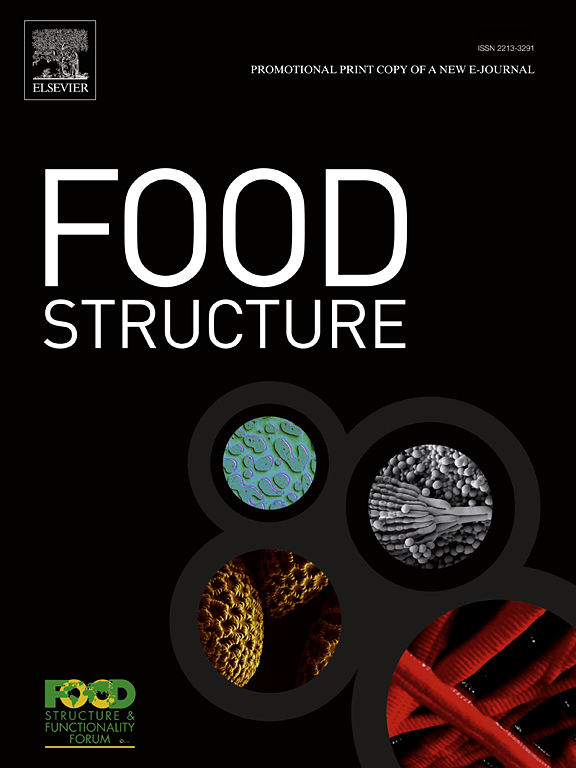南瓜籽干燥过程中的热变形行为及微观结构响应
IF 5.9
3区 农林科学
Q1 FOOD SCIENCE & TECHNOLOGY
引用次数: 0
摘要
尽管热风干燥在南瓜籽加工中得到了广泛的应用,但南瓜籽的干燥变形行为和微观结构响应机制尚不清楚。采用数字图像相关方法(DIC)和细胞形态分析技术,系统分析了35℃、40℃、45℃、50℃、55℃、60℃、65℃和70℃不同干燥温度下种子的含水量演变、应变场分布和细胞结构响应。结果表明,在70℃下干燥到安全含水率(9.0 ± 0.5 %)的时间仅为35℃下干燥时间的2/9。南瓜籽变形表现出明显的各向异性,小轴方向的应变绝对值εx(35℃时为- 0.017 ~ - 0.056,70℃时为- 0.011 ~ - 0.072)高于长轴方向的应变绝对值εy(35℃时为- 0.016 ~ - 0.036,70℃时为- 0.029 ~ - 0.056)。南瓜籽在50℃以下以可逆弹性收缩为主,在50 ~ 70℃干燥时进入塑性变形阶段。应变场异质性的增强反映了种子核缘之间的协同作用。随着温度的升高,孔隙率呈不断增大的趋势,而平均胞面积、胞径和周长均呈减小趋势。从弹性变形到塑性变形的转变发生在50°C左右,这是一个临界阈值。本研究为南瓜籽热风干燥工艺的优化提供了依据,为农业应用中种子和食品的危害最小化干燥提供了实践指导。本文章由计算机程序翻译,如有差异,请以英文原文为准。
Thermal deformation behavior and microstructural response of pumpkin seeds during drying
Despite the widespread use of hot air drying in seed processing, the mechanisms of drying-induced deformation behavior and microstructural response in pumpkin seeds is not well understood. The moisture content evolution, strain field distribution, and cellular structural responses of seeds under varying drying temperatures (35℃, 40℃, 45℃, 50℃, 55℃, 60℃, 65℃, and 70℃) were systematically analyzed using digital image correlation method (DIC) and cell morphology analysis. The results showed that the drying time to the safe moisture content (9.0 ± 0.5 %) at 70℃ was only 2/9 of that at 35℃. The deformation of pumpkin seeds showed obvious anisotropy, with higher absolute value of strain in the minor axis direction (from −0.017 ∼ −0.056 at 35°C to −0.011 ∼ −0.072 at 70°C) compared to the major axis (from −0.016 to −0.036 at 35°C to −0.029 ∼ −0.056 at 70°C). The pumpkin seeds were dominated by reversible elastic contraction at 50°C or less, and entered the plastic deformation stage when the drying temperature was 50–70°C. The intensified heterogeneity of the strain field reflected the synergistic interaction between the core and edge of seed. The porosity showed a continuous increasing trend with rising temperature, while the average cell area, Feret diameter, and perimeter decreased. The transition from elastic to plastic deformation was observed to occur at around 50°C, which serves as a critical threshold. This study provides a basis for optimizing the hot air drying process of pumpkin seeds, which offering practical guidance for damage-minimized seed and food drying in agricultural applications.
求助全文
通过发布文献求助,成功后即可免费获取论文全文。
去求助
来源期刊

Food Structure-Netherlands
Chemical Engineering-Bioengineering
CiteScore
7.20
自引率
0.00%
发文量
48
期刊介绍:
Food Structure is the premier international forum devoted to the publication of high-quality original research on food structure. The focus of this journal is on food structure in the context of its relationship with molecular composition, processing and macroscopic properties (e.g., shelf stability, sensory properties, etc.). Manuscripts that only report qualitative findings and micrographs and that lack sound hypothesis-driven, quantitative structure-function research are not accepted. Significance of the research findings for the food science community and/or industry must also be highlighted.
 求助内容:
求助内容: 应助结果提醒方式:
应助结果提醒方式:


